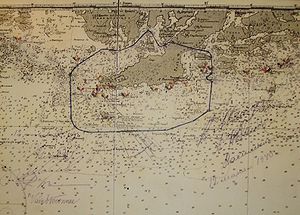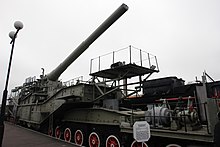
The Continuation War, also known as the Second Soviet-Finnish War, was a conflict fought by Finland and Nazi Germany against the Soviet Union during World War II. It began with a Finnish declaration of war and invasion on 25 June 1941 and ended on 19 September 1944 with the Moscow Armistice. The Soviet Union and Finland had previously fought the Winter War from 1939 to 1940, which ended with the Soviet failure to conquer Finland and the Moscow Peace Treaty. Numerous reasons have been proposed for the Finnish decision to invade, with regaining territory lost during the Winter War regarded as the most common. Other justifications for the conflict include Finnish President Risto Ryti's vision of a Greater Finland and Commander-in-Chief Carl Gustaf Emil Mannerheim's desire to annex East Karelia.

Hanko is a town in Finland, located in the southern coast of the country. Hanko is situated in the western part of the Uusimaa region. The population of Hanko is approximately 8,000, while the sub-region has a population of approximately 40,000. It is the 121st most populous municipality in Finland.

Porkkalanniemi is a peninsula in the Gulf of Finland, located at Kirkkonummi (Kyrkslätt) in Southern Finland.

The Finnish Navy is one of the branches of the Finnish Defence Forces. The navy employs 2,300 people and about 4,300 conscripts are trained each year. Finnish Navy vessels are given the ship prefix "FNS", short for "Finnish Navy ship", but this is not used in Finnish-language contexts. The Finnish Navy also includes coastal forces and coastal artillery.

The Hanko Peninsula, also spelled Hango, is the southernmost point of mainland Finland. The soil is a sandy moraine, the last tip of the Salpausselkä ridge, and vegetation consists mainly of pine and low shrubs. The peninsula is known for its beautiful archipelago and long sandy beaches.

The Baltic Sea campaigns were conducted by Axis and Allied naval forces in the Baltic Sea, the Gulf of Bothnia, the Gulf of Finland and the connected lakes Ladoga and Onega on the Eastern Front of World War II. After early fighting between Polish and German forces, the main combatants were the Kriegsmarine and the Soviet Navy, with Finland supporting the Germans until 1944 and the Soviets thereafter. The Swedish Navy and merchant fleet played important roles, and the British Royal Navy planned Operation Catherine for control of the Baltic Sea and its exit choke point into the North Sea.
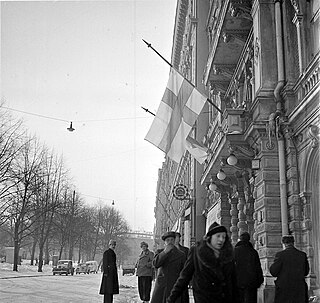
The Interim Peace was a short period in the history of Finland during the Second World War. The term is used for the time between the Winter War and the Continuation War, lasting a little over 15 months, from 13 March 1940 to 24 June 1941. The Moscow Peace Treaty was signed by Finland and the Soviet Union on 12 March 1940 and it ended the 105-day Winter War.

Vesihiisi was a Finnish 500-tonne Vetehinen-class submarine that was constructed in the early 1930s. The vessel served in the Finnish Navy during the second World War.

Turunmaa was a Finnish gunboat built in 1918. She served in the Finnish Navy during World War II. The ship was named after Turuma, a type of frigate designed for use in shallow waters of the archipelago and served in the Swedish Archipelago fleet in the late 18th century. The frigates had in turn been named after the region of Finland.

The Battle of Suursaari was fought over the frozen Gulf of Finland on and around the islands of Gogland and Bolshoy Tyuters during the Second World War. After sharp fighting the numerically superior Finnish forces seized the Gogland and Bolshoy Tyuters, and later provided support for Nazi German forces defending Bolshoy Tyuters against Soviet counterattacks.
Finnish Ladoga Naval Detachment was a Finnish naval unit stationed on Lake Ladoga between 1920–1940 and 1941–1944.

The Soviet evacuation of Tallinn, also called Juminda mine battle, Tallinn disaster or Russian Dunkirk, was a Soviet operation to evacuate the 190 ships of the Baltic Fleet, units of the Red Army, and pro-Soviet civilians from the fleet's encircled main base of Tallinn in Soviet-occupied Estonia during August 1941. Near Juminda peninsula Soviet fleet ran into minefield that had been laid by the Finnish and German navies, and were repeatedly attacked by aircraft and torpedo boats, incurring major losses.
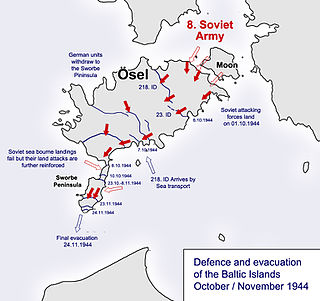
The Moonsund landing operation, also known as the Moonzund landing operation, was an amphibious operation and offensive by the Red Army during World War II, taking place in late 1944. It was part of the Baltic offensive, and was designed to clear German forces of Army Group North from the islands in East Baltic Sea, the West Estonian archipelago. The attacking forces were from the 8th Army of the Leningrad Front.

The Battle of Someri took place in the Gulf of Finland during World War II on 8–9 July 1942, between the Soviet Union and Finland. Starting as a modest operation to clear a Finnish observation post from a small island, it became one of the largest surface ship engagements in the Baltic theater.
The Naval warfare in the Winter War was the naval part of the Winter War between Finland and the Soviet Union from 30 November 1939 to 13 March 1940. Overall, the level of naval activity was low. However, Finland had coastal artillery batteries which took part in battles along its coast.
Turku Coastal Regiment was a Finnish coastal artillery unit operating in the Turku area and Archipelago Sea. It was formed on 10.9.1939 as Turku Sector as part of the neutrality guard and later Winter War coastal sector system from a peace time 1st Independent Coastal Artillery Battalion. Turku Coastal Regiment was disbanded as an independent unit on 30.6.1998 and became part of the newly formed Archipelago Sea Naval Command as Turku Coastal Artillery Battalion.
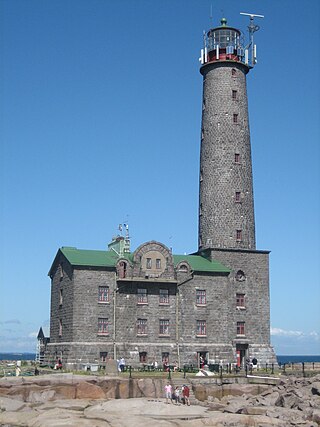
Bengtskär Lighthouse is located in the Archipelago Sea about 25 kilometers south west of Hanko, Finland. The lighthouse was built in 1906 on the Bengtskär skerry where it rises 52 meters above sea level and is the highest one in the Nordic countries. The lighthouse had been planned for some time, but after the steamer s/s Helsingfors ran aground in 1905 in the vicinity en route from Lübeck to Helsinki resulting in several crew members trapped and drowned on board, the project gained urgency and was completed during the following year. Soviet troops stationed in Hanko during the Continuation War, disturbed by a Finnish observation post in the light house tried to blow up and destroy the lighthouse during the Battle of Bengtskär in 1941.

Hanko Naval Base was a Soviet naval base from 1940 to 1941 in the town of Hanko at the Hanko Peninsula, which is located 100 kilometers (62 mi) from Helsinki, the Finnish capital.

The Invasion of Åland was a 1918 military campaign of World War I in Åland, Finland. The islands, still hosting Soviet Russian troops, were first invaded by Sweden in late February and then by the German Empire in early March. The conflict was also related to the Finnish Civil War including minor fighting between the Finnish Whites and the Finnish Reds.

Smetlivy was one of 29 Gnevny-class destroyers built for the Soviet Navy during the late 1930s. Completed in 1938, she was assigned to the Baltic Fleet and played a minor role in the 1939–1940 Winter War against Finland. After the start of the German invasion of the Soviet Union in June 1941, the ship participated in the Gulf of Riga Campaign before withdrawing to Tallinn, Estonia. Smetlivy supported Soviet forces during the defense of Tallinn in August and covered the subsequent evacuation to Leningrad. The ship provided naval gunfire support to the defenders of Leningrad over the next several months before she was assigned to evacuate Soviet troops from their enclave in Hanko, Finland, in November. Smetlivy struck several mines returning from Hanko and sank with heavy loss of life.
